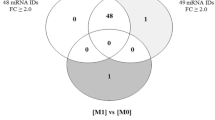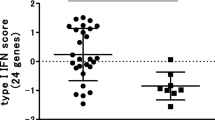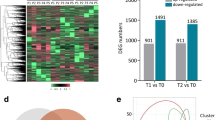Abstract
Psoriatic arthritis (PsA) is a systemic inflammatory condition associated with psoriasis. Despite considerable heterogeneity in clinical presentation, genetic studies and animal models support the notion that PsA is a distinct disease. We aimed to characterize the PsA genotype by gene expression profile and to research the effect in gene modulation of methotrexate (MTX) and TNF-inhibitors (TNF-I) in PsA-treated patients. Nine PsA patients, according to CASPAR criteria, and three healthy controls were recruited from an outpatient rheumatology clinic. Three out of nine PsA patients were naïve to treatment, three received TNF-I, and the remaining three were on MTX-monotherapy. Blood samples were collected and analyzed by human genome U95 Array-Affymetrix (GeneChip® instrument system). Identification of statistically significant differences between differentially expressed genes was determined by Mann–Whitney and t test (p < 0.05). The microarray profile identified a predominance of differentially expressed genes with an increased expression in baseline PsA patients: 115/12,000 genes were up-regulated and 13/12,000 down-regulated, as compared to healthy controls. The great majority were involved in inflammatory cells and pathways. In the biologic-treated patients, a higher number of down-regulated genes were expressed vs. the MTX patients, 161 vs. 33, respectively. This study shows that in PsA patients, TNF-I and MTX are able to modulate the gene expression in a synergistic and additive manner.
Similar content being viewed by others
Avoid common mistakes on your manuscript.
Introduction
Psoriatic arthritis (PsA) is a chronic and systemic inflammatory disease associated with psoriasis (Ps), which can lead to significant joint and bone damage, reduced quality of life, and functional impairment. The pathogenesis of these disorders is still poorly understood, but growing evidence suggests the presence of a complex dysregulation of immunological, inflammatory, and vascular pathways, in a genetically predisposed host [1], supported by its association with certain HLA class I haplotypes (B-38, B-39, TRAF3-IP2) and with the activation of cells and pathways of the innate and adaptive immune system, that includes T helper (h)-1 and Th-17 cells. These lead to an excessive production of several pro-inflammatory cytokines and proteins such as IL-17 A-F, IL-22, IL-23 IL-1β, TNF-α, TGF-β, IFN-γ, CXCL-10, GM-CSF, growth factors (VEGF, PDGF, Ang), MMPs, PGE2, M-CSF, ADAMTs, RANKL, Dkk-1, and BMP, especially BMP7 that in the skin leads to the development of keratinocyte hyperplasia characterized by healing without scarring, and with IL-22 favors osteoproliferation. In contrast, in the joint organ, the presence of cartilage loss, bone erosions, and osteoproliferation leads to permanent tissue damage [2–6].
The wide clinical spectrum observed in PsA, including the variable response to different therapies, it is likely to be a reflection of underlying genetic heterogeneity. Recent research has demonstrated that the association of numerous genes with skin barrier function and innate and adaptive immunity may play a role in the pathogenesis of Ps and PsA [7, 8].
It has been largely demonstrated that TNF-α and IL-17/IL-22 play a synergistic role in the skin and joint organ in PsA. Methotrexate (MTX) is the first-line systemic therapy used for the treatment of moderate to severe Ps and PsA, but has variable clinical response. Furthermore, data from clinical trials using TNF-I in PsA patients has shown good efficacy in controlling signs and symptoms as well as function [9]. The precise immunomodulatory mechanisms by which these drugs exert their effect in PsA still remain an open question.
In recent years, the advent of new microarray technologies and the discovery of new gene expression profiles have established the basis to generate new hypotheses related to the pathogenesis of several autoimmune diseases. This information provides insights into the tissue changes during the disease development and enables targets for therapeutic intervention to be identified. Microarray analysis from peripheral blood cells conducted in patients with systemic lupus erythematosus (SLE) [10], rheumatoid arthritis (RA) [11], and ankylosing spondylitis (AS) [12] have identified several genes that are differentially expressed in these diseases as compared to controls. In PsA, however, only a small number of case–control genomic profiling studies have been undertaken. The effect of conventional DMARDs (MTX) on gene function and expression in PsA patients has not yet been investigated.
Therefore, in this cross-sectional pilot study, we aimed to identify which genes and chromosomes are regulated by the disease, and to evaluate the effect of TNF-I and MTX therapies on the modulation of the expressed genes.
Materials and methods
Patients and controls
PsA patients were diagnosed according to CASPAR criteria [13]. In this study, nine active PsA patients and three healthy controls were analyzed. Mean disease duration was 5 years [SD (standard deviation) 12 years]. All had a moderate disease characterized by a polyarticular pattern. Three out of nine PsA patients were naïve to treatment, three received TNF-I therapy (Etanercept) and the remaining three were on monotherapy with MTX (10–15 mg PO weekly), mean treatment duration 1.5 years. The study was approved by the Institutional Review Board at Louisiana State University Health Sciences Center (LSUHSC). All patients were recruited from the arthritis clinic at the LSUHSC (New Orleans, LA). Informed written consent was obtained from all patients and controls that provided blood samples.
RNA isolation and labeling
Venous blood (10 ml) was collected in PAXgene sample tubes (PreAnalytiX). Total RNA was obtained using the PAXgene Blood RNA Kit per manufacturer’s instructions. RNA was quantified using the Agilent RNA 6000 Nano Assay Protocol. Typical yield of total RNA was 40 g per 10 ml of blood. Subsequent cDNA/cRNA synthesis was performed with 1 g of total RNA using the MessageAmpaRNA Kit (Ambion). The cRNA was labeled with Biotin-11-CTP (Perkin Elmer) and Biotin-16-UTP (Roche) before hybridization.
Sample processing and microarray analysis
Twenty to 30 ml of blood from patients and controls were drawn by venipuncture using BD Vacutainer CPT tubes with Sodium Heparin (BD, Franklin Lakes, NJ). Tubes were centrifuged at room temperature for 15 min at 1500 RCF and PBMCs harvested. All samples were processed within 30 min after drawn. Total RNA from PBMCs was obtained and purified using the RNeasyPlus Mini Kit (Quiagen, Gaithersburg, MD). The quality of each RNA samples was verified by running the samples on a 1 % agarose gel. Microarray was performed using the human 133A 2.0 gene chip platform.
Total RNA was used to synthesize cDNA; labeled and fragmented cDNA was hybridized, washed, stained, and scanned using a GeneChip® instrument system (Affymetrix-eBioscience, San Diego, CA).
Data acquisition and analysis
Starting with total RNA, DNA microarray involving 12,000 known genes (human genome U95 Array-Affymetrix, human expression database), was used to obtain gene expression (signal) profiles in the 12 samples studied. Databases used to analyze gene expression function and locations were: mged.org, ncbi.nlm.nih.gov/geo, and gene cards. Identification of statistically significant differences between genes was determined by Mann–Whitney and t test (p < 0.05). The following criteria were applied to generate a list of genes that were differentially expressed between PsA patients and healthy controls:
-
For up-regulated genes, (i) one transcript had to be present in greater than 50 % of the samples in the experimental group, (ii) test for significance must be significantly up by either an unpaired t test or Mann–Whitney, (iii) change call must be increased in greater than 50 % of samples, and (iv) median log ratio must be ≥1.
-
For down-regulated genes, (i) one transcript had to be present in at least 50 % of the control group, (ii) test for significance must be significantly down (t test or Mann–Whitney), (iii) change call must be decreased in at least 50 % of the samples, and (iv) median log ratio must be ≤1.
The expression value for each gene was converted to a “fold difference” by dividing each baseline signal value by the mean signal value of that gene in the experimental array. These changes were expressed as log2 ratio and hierarchically clustered with corresponding software. A signal log ratio of 1 was equivalent to a fold change of 2.
Results
The microarray profile identified 128/12,000 genes with a significant differential expression between PsA naïve to treatment and healthy controls. There was a predominance of genes with increased expression in baseline PsA patients: 115/12,000 genes were up-regulated and 13/12,000 were down-regulated, as compared to controls. These data were clustered and visualized as shown in Fig. 1.
Experimental tree demonstrating distinct genetic profile among baseline PsA patients, PsA/MTX and PsA/TNF-treated groups, as compared with healthy controls. Expression values intensities are depicted according to the color-indicator key and range from 0 to 5 on a log2 scale. Red indicates genes that are up-regulated and blue indicates genes that are down-regulated relative to the mean expression levels
The analysis of gene expression in PsA vs. controls in the TNF-I and MTX groups showed that 27 genes were found up-regulated, while 161 genes were down-regulated in TNF-I-treated patients. In addition, 33 genes were found to be down-regulated, while 12 genes had shown an increased expression in the PsA/MTX group (data not shown).
In baseline PsA patients, differentially expressed genes (DEG) were involved in several regulatory functions and pathways, including: proliferative genes, such as TCP1 (4.6), MPS-1 (4.4); apoptosis-related, such as KIAA0026 (4.0), GTP-TTF (3.4), BCLX (−3.0), CRE-BP1 (−3.0); keratinocytes, Annexin-1 (4.24), TCPT (3.0); basophiles, TCPT (3.0); cell adhesion molecules, Annexin-1 (4.2), Rap 1 (3.0); HSP-90KD (4.0), HSP-70KD (3.2); pro-inflammatory cytokines/chemokine genes, CC-CKR-2 (3.4), IL-1β-converting enzyme (3.6), TGF-β (−2.8), IL-8 R (2.8); transcription factors, KIAA0026 (3.6); metabolic pathways, ubiquinol-cytochrome C reductase (7.0), NADPH dehydrogenase B (5.0), PSC8-9 (3.0), PS alpha type (5.4), retroviral proteins, CCr2b (3.0), L6 (4.0), and EBV (3.2), among others (Table 1).
In PsA/TNF-I and PsA/MTX-treated patients, down-regulated gene functions included: keratinocytes, Sp1 (−3.0), hn RNPK (−3.8), calmodulin (−3.6); fibroblast functions, basagin precursor (−3.0) collagen type-I Ag M6 (−3.8), apoptosis-related, TRE (−7.2), DUSP6 (−5.0), serine palmytoiltransferase (−3.5); transcription factors, N-myc-interactor (−3.2), DSF70 (−6.0); HSP70KD (−3.2), HSP TF2 (3.2); cell cycle regulators, DSF70 (−6.0), htra-2 beta (−5.4), DUSP6 (−5.0); osteoclastic activity, HSINFGRA7 (−3.6), cytokine production and their receptors, TGF-β-activated kinase (−6.6), CCR2/CCR5/CCR6 (−5.0), PBEF (−3.6), CD27 (−3.0), IFN-gamma-receptor (−3.6), adhesion molecules, complement pathway, clotting factors, HLA class I and II, such as HLA-DRw53 (−3.4), DR7 (−1.3); retrovirus proteins, such as retroviral protease (−4.6), DBX (−3.4), CCR (−3.6), retinoblastoma-like protein 2 (−3.6), 292E10 (3.0); angiogenesis, EDF1 (−3.2), chemok C-X-C (−3.2), EGF (−2.6), among others (Table 1).
Several of the characteristic PsA chromosomes were targeted by both compounds MTX and TNF-I. The chromosomes targeted by the disease were 1, 2, 3, 4, 5, 6, 7, 8, 9, 10, 11, 12, 13, 14, 15, 17, 18, 19, 21, 22, and X. The chromosomes targeted in PsA patients with TNF-I therapy were 1, 3, 5, 6, 7, 8, 9, 10, 11, 14, 16, 17, 19, 21, 22, and X. Lastly, chromosomes targeted by MTX in PsA patients were 1, 2, 3, 4, 5, 6, 7, 10, 12, 13, 16, 17, 19,20, 22, and X (Fig. 2).
Discussion
In this pilot study, the analysis of gene expression profile in baseline PsA patients identified a predominant up-regulation in the expression of DEG (115 genes up-regulated vs. 13 down-regulated genes). Most of the up-regulated genes are involved in several cellular functions and immune pathways, which include T- and B-cell activation, apoptosis, transcription factors, chemokine/cytokine signaling, keratinocytes proliferation, and metabolic pathways.
Our findings are in agreement with previous studies conducted to determine the genetic expression profile in peripheral blood of PsA patients. In a small study where a restricted 588-gene chip was used, Gu et al. found that 14 genes were up-regulated in PsA patients compared to healthy controls; the majority of those were associated with inflammatory pathways [14]. More recently, Stoeckman et al. compared the gene expression profile in whole blood from 16 PsA patients and 15 controls, using last-generation microarray chip. They found that more than 200 genes were up-regulated in PsA patients, while 74 genes were down-regulated [15]. Nonetheless, a microarray analysis from peripheral blood cells in PsA performed by Batliwalla et al. have identified a predominance of down-regulated genes in PsA patients, although most of them were involved in down-regulation or suppression of innate and adaptive immune responses, suggesting a tendency toward a pro-inflammatory response [16]. It is necessary to annotate that we have identified in our PsA patient population other set of DEGs that have not being identified in previous studies [17, 18].
In this study, microarray gene expression in PsA patients treated with a TNF-I show a dramatic predominance of down-regulated gene expression (161 genes) vs. up-regulated genes (27). Most of the down-regulated genes were involved in relevant inflammatory pathways (e.g., pro-inflammatory cytokines, adhesion molecules, cell-signaling pathways, transcription factors, and chemiotaxis/phagocytosis). In addition, TNF-I have also shown to have a regulatory effect in genes involved in different cellular functions implicated in the pathophysiology of Ps and PsA [19, 20]. In this study, down-regulated gene functions included keratinocytes, osteoclast activity, neutrophil function, collagen type I-II, fibroblasts, and complement pathway.
Moreover, this is the first study that demonstrates the mechanism of action of MTX in PsA at the gene level, these findings add in the understanding of the clinical efficacy in the disease.
In addition, down-regulation of a variety of gene functions observed in our PsA patients receiving MTX and TNF-I, might add some insights regarding the mechanism of action of these therapies. It should be noted that these immunomodulatory drugs, especially TNF-I, have shown the ability to reverse the gene expression (genome) in PsA patients that close to the level of healthy controls. Although in the light of our findings, the effect of MTX should not be minimized.
In conclusion, TNF-α inhibition in PsA patients resulted in a greater immunomodulatory activity, but at the same time, synergistic to MTX therapy. According to our findings, it can be argued that TNF-I may not be considered as specific agent blocking TNF-α, due to its ability to modulate a number of different pathways not related to the innate and adaptive immune system.
Abbreviations
- PsA:
-
Psoriatic arthritis
- Ps:
-
Psoriasis
- MTX:
-
Methotrexate, TNF-α, tumor necrosis factor-α
- SLE:
-
Systemic lupus erythematosus
- RA:
-
Rheumatoid arthritis
- AS:
-
Ankylosing spondylitis
- PBMCs:
-
Peripheral blood mononuclear cells
- DNA:
-
Deoxyribonucleic acid
- DEG:
-
Differentially expressed genes
- TGF-β:
-
Transforming growth factor beta
- BMP:
-
Bone morphogenetic protein
- IFN-γ:
-
Interferon gamma
References
O’Rielly D, Rahman P (2011) Genetics of susceptibility and treatment response in psoriatic arthritis. Nat Rev Rheumatol 7:718–723
Lories RJ, de Vlam K (2012) Is psoriatic arthritis a result of abnormalities in acquired or innate immunity? Curr Rheumatol Rep 14:375–382
McGonagle D, Lories RJ, Tan AL et al (2007) The concept of a “synovio-entheseal complex” and its implications for understanding joint inflammation and damage in psoriatic arthritis and beyond. Arthritis Rheum 56:2482–2491
Yeremenko N, Noordenbos T, Cantaert T et al (2013) Disease-specific and inflammation-independent stromal alterations in spondyloarthritis synovitis. Arthritis Rheum 65:174–185
Nestle FO, Kaplan D, Barker J (2009) Psoriasis. N Engl J Med 361:496–509
Reveille JD (2012) Genetics of spondyloarthritis: beyond the MHC. Nat Rev Rheumatol 8:296–304
Chandran V, Raychaudhuri SP (2010) Geoepidemiology and environmental factors of psoriasis and psoriatic arthritis. J Autoimmun 34:J314–J321
Ogilvie AL, Luft M, Antoni C (2006) Leukocyte infiltration and mRNA expression of IL-20, IL-8 and TNF-R P60 in psoriatic skin is driven by TNF-alpha. Int J Immunopathol Pharmacol 19(2):271–278
Gossec L, Smolen J, Gaujoux-Viala C et al (2012) European League Against Rheumatism recommendations for the management of psoriatic arthritis with pharmacological therapies. Ann Rheum Dis 71:4–12
Baechler EC, Batliwalla FM, Karypis G et al (2003) Interferon-inducible gene expression signature in peripheral blood cells of patients with severe lupus. Proc Natl Acad Sci U S A 100(5):2610–2615
Batliwalla FM, Baechler EC, Xiao X et al (2005) Peripheral blood gene expression profiling in rheumatoid arthritis. Genes Immun 6(5):388–397
Pimentel-Santos F, Ligeiro D, Matos M et al (2011) Whole blood transcriptional profiling in ankylosing spondylitis identifies novel candidate genes that might contribute to the inflammatory and tissue-destructive disease aspects. Arthritis Res Ther 13:R57
Taylor WJ, Gladman DD, Helliwell PS et al (2006) Classification criteria for psoriatic arthritis: development of new criteria from a large international study. Arthritis Rheum 54:2665–2673
Gu J, Marker-Hermann E, Baeten D et al (2002) A 588-gene microarray analysis of the peripheral blood mononuclear cells of spondyloarthropathy patients. Rheumatology 41:759–766
Stoeckman AK, Baechler EC, Ortmann WA et al (2006) A distinct inflammatory gene expression profile in patients with psoriatic arthritis. Genes Immun 7:583–591
Batliwalla FM, Wentian L, Ritchlin C et al (2005) Microarray analysis of peripheral blood cells identifies unique gene expression signature in psoriatic arthritis. Mol Med 11:1–12
Shi L, Perkins RG, Fang H et al (2008) Reproducible and reliable microarray results through quality controls: good laboratory proficiency and appropriate data analysis practices are essential. Curr Opin Biotechnol 19:10–18
Simon R (2008) Microarray-based expression profiling and informatics. Curr Opin Biotechnol 19:26–29
Van Kuijk AW, Reinders-Blankert P, Smeets TJ et al (2006) Detailed analysis of the cell infiltrate and the expression of mediators of synovial inflammation and joint destruction in the synovium of patients with psoriatic arthritis: implications for treatment. Ann Rheum Dis 65(12):1551–1557
Mease P (2011) Psoriatic arthritis: update on pathophysiology, assessment and management. Ann Rheum Dis 70:i77–i84
Acknowledgments
We would like to thank Ms. Jill Schurr for her assistance in the microarray analysis.
Conflict of interest
None.
Author information
Authors and Affiliations
Corresponding author
Rights and permissions
About this article
Cite this article
Cuchacovich, R., Perez-Alamino, R., Zea, A.H. et al. Distinct genetic profile in peripheral blood mononuclear cells of psoriatic arthritis patients treated with methotrexate and TNF-inhibitors. Clin Rheumatol 33, 1815–1821 (2014). https://doi.org/10.1007/s10067-014-2807-8
Received:
Revised:
Accepted:
Published:
Issue Date:
DOI: https://doi.org/10.1007/s10067-014-2807-8






